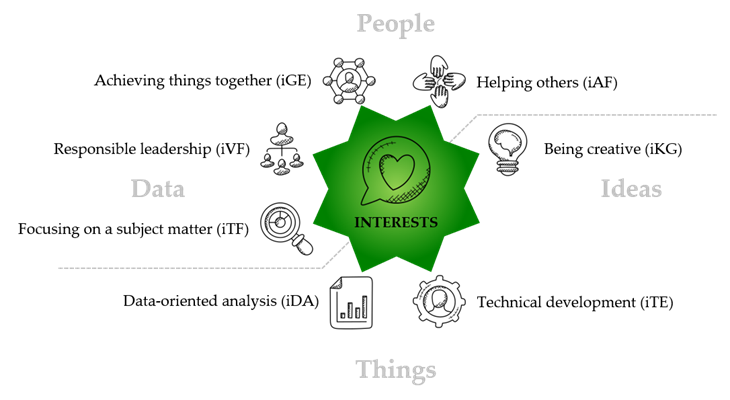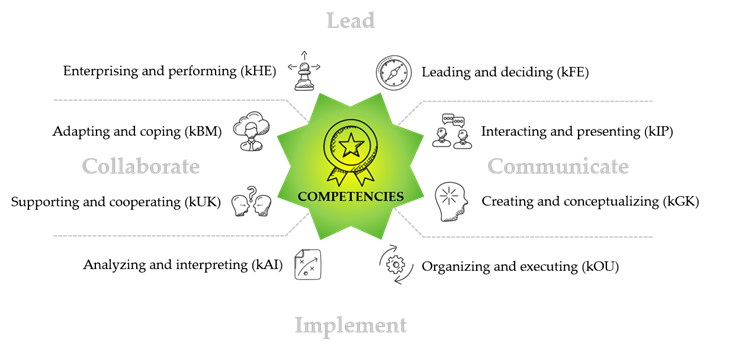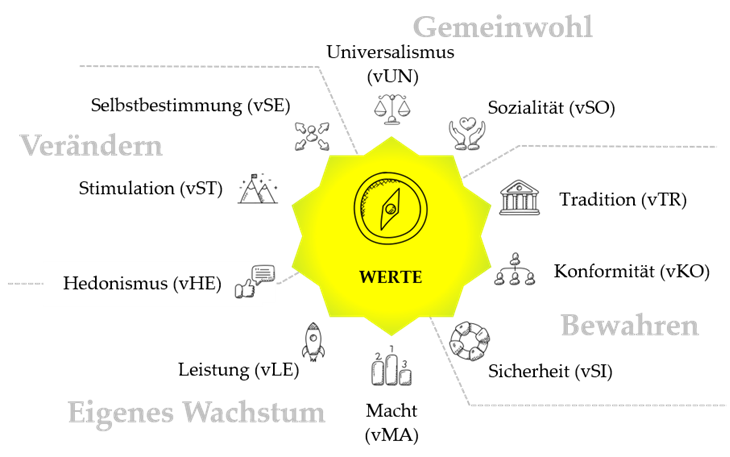The key dimensions of the Swiss Career Survey
At the core of our study are the three dimensions of work-related interests, competences, and values.

The interests address the complex of questions around "What do I want? These include questions such as "What drives me," "What activities do I enjoy," and "What occupations give you the energy you can use for other activities". Work is "doing" - a draft of a professional career basically describes how to define a portfolio of activities that are enjoyable. This is where our reflection starts. Learn more about the concept used
The competences address the complex of questions around "What do I like? These include questions such as "What am I capable of doing", "Which competences do I use to meet the challenges I face" and "Where are my limits? Work is "demonstrated ability" - a promising outline of a professional career is related to experienced self-efficacy. Here our reflection continues. Learn more about the concept used
The values address the complex of questions surrounding "Which environments am I looking for? These include questions such as "What are the basic assumptions I follow or avoid," "What beliefs do I follow," and "What demands do I place on my work environments? Work is "social interaction" - a useful career blueprint should reflect meaning, belonging, and teamwork as a basis for collaboration. Learn more about the concept used
The concepts operationalised in the Swiss Career Survey
In order to ascertain job-related interests, we have developed our own measuring instrument, which is based conceptually on elements of the Personal Globe Inventory (PGI)[1]. The PGI is particularly suitable for us because it basically covers a somewhat broader range of activities than those found in administrative positions in companies. For example, in addition to classic administrative activities such as data-oriented analysis or expert work in a specialist field, it also covers activities in nature, mechanics and technology or design. It is important that the horizon of possible career options is not narrowed down too much, especially in this subject area, which is always the first to be surveyed in the study. In our survey, we have opted for a simplified version of the CIP, which takes into account eight facets of activity: joint achievement, responsible leadership, thematic focusing, data-oriented analysis, engineering, discovering nature, creative design, and promoting others. The model divides the activities into four quadrants, depending on whether the activities are more related to things or people or data or ideas. Learn more about the interest factors and related items.

To measure job-related skills, our measurement tool is based on the Great Eight (GE)[2] model. The GE deliberately focuses more on the skills that are associated with employee performance in business environments. Eight dyadic facets are considered, which together form a competence profile: analysing and interpreting, designing and conceptualising, managing change and mastering challenges, supporting and cooperating, interacting and presenting, leading and deciding, organising and implementing, entrepreneurial action and achieving goals. Although the facets of the model were not grouped by its original authors, we divide the eight facets into four groups according to competencies of leading, communicating, realising, and collaborating. Learn more about the competence factors and related items.

In order to assess the values related to the workplace, our measurement tool is based on the Schwartz Value Survey (SVS)[3] model. While the SVS was not originally developed for the workplace, we have operationalised it for our study. With its 10 factors, the SVS forms a balanced and sufficiently comprehensive model for collecting a value profile of our participants. The SVS considers universalism, sociality, conformity, tradition, need for security, power and performance orientation, hedonism, stimulation and self-determination. The model also allows for an examination in two overarching areas of tension between openness to change and preserving behaviour and between social and self-orientation. Learn more about the value factors and related items.

[1] Tracey, T. J. (2002). Personal Globe Inventory: Measurement of the spherical model of interests and competence beliefs. JVocBeh, 60(1), 113-172.
[2] Bartram, D. (2005). The Great Eight competencies: a criterion-centric approach to validation. Journal of applied psychology, 90(6), 1185.
[3] Schwartz, S. H. (2012). An overview of the Schwartz theory of basic values. Online readings in Psychology and Culture, 2(1), 11.